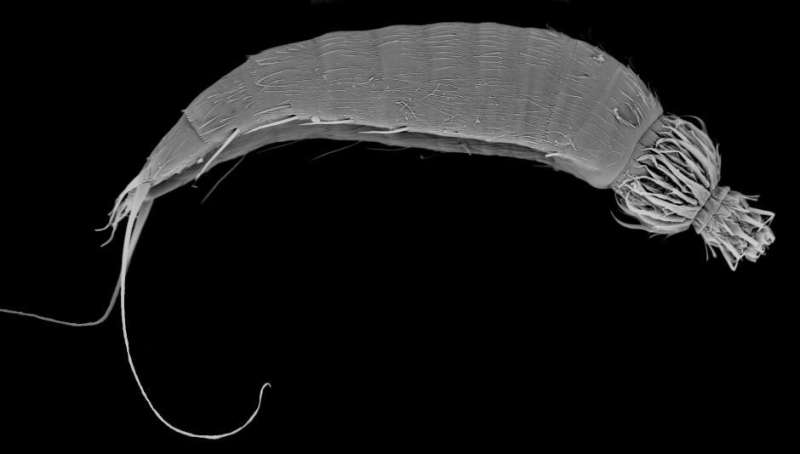Meet the mud dragon—the tiny animal that lives on the beach

You might not know it, but you have probably met the mud dragon before. They live at the beach, hidden in the sand and floating in the shallows.
These microscopic animals are found all over the world, from the cold deep ocean to shallow tropical lagoons. Yet, we know almost nothing about them.
Generations of scientists have neglected these tiny animals and in 2018 we still do not know what they eat or what role they play in the marine ecosystem.
"We've known about this group of animals since the mid-1800s. But we still know almost nothing about them. Very few scientists have studied them even though they're an absolutely fascinating animal," says Martin Vinther Sørensen, who in his own words is one of the 10 to 15 scientists who have ever studied mud dragons.
A dragon-like look
Listening to Sørensen talk, it is hard to understand why scientists have not studied them with greater interest.
Despite their unimpressive size, no more than 1 millimetre long, mud dragons have an unusual sex life and a caring attachment to their young.
And when viewed under the microscope, a dragon appears.
"They resemble small dragons with spines all the way down their body," says Sørensen, an associate professor at the Danish Natural History Museum and the University of Copenhagen, Denmark who has studied mud dragons for 20 years.
"They can also withdraw the head into the trunk, and cover the head opening with plates on the neck—like a turtle hiding its head under its shell. But we don't know why they do this," he says.
Fifteen species found in Norway
Norwegian professor, Lutz Bachmann from the Norwegian Natural History Museum at the University of Oslo, confirms the overlooked nature of mud dragons, despite their fascinating characteristics.
"It's a really neglected group of animals. Hardly anyone studies these basic invertebrates. Martin (Sørensen) is perhaps the only one in the world who has studied most of them," says Bachmann, professor in molecular systematics.
Bachmann was involved in a large-scale project to map all animal species in Norway. At this time, nobody knew how many species of mud dragon there were in the country.
"We started collecting samples along the coast and we found at least 15 or 16 different species," he says.
Named after Game of Thrones
There are more than 200 known species of mud dragons around the world and that number is growing steadily, according to a recent study by Sørensen.
In 2017 alone, he identified four new species.
He discovered one of these in the Gulf of Mexico. The other three were discovered in Svalbard, and are named after dragons from the TV series, Game of Thrones.
"I'm sure I could also find new species in Denmark if I had the money to travel and collect samples in the Kattegat or other deep waters," Says Sørensen. "But there's no money for that kind of research here anymore, so I have to look abroad."
Sørensen received funding to investigate mud dragons in the Gulf of Mexico as part of an initiative to map biodiversity, following the Deepwater Horizon oil spill in 2010.
What do they eat?
One question that Sørensen would love to be able to answer is: What do mud dragons eat?
To answer this he would need to dissect and analyse the DNA of their stomach contents.
"We think that they primarily eat bacteria and microalgae, but it's never been shown. I'd like to investigate that with the help of DNA but that project is on the shelf and I haven't started it yet," he says.
Closest relative is the penis worm
While mud dragons may bear some resemblance to a tiny shrimp, they are an entirely different animal group, says Sørensen.
"Their nearest relatives are two groups, which few people know about: the loriciferans and the penis worm," he says.
These small marine animals have an impressive lineage. Fossil evidence suggests that the majority of living animals are descended from the penis worm. And, scientists think that their close relation, the mud dragon, could have a similarly long lineage.
"There are no good quality, old fossils of mud dragons. But based on their place in the animal kingdom, we can say with fairly high certainty that mud dragons have existed for a long time. Much longer than we have," says Bachmann.
A unique sex life
The microscopic mud dragon has two genders and is equipped with genitalia that are visible under a microscope.
Scientists are not sure how exactly they use these organs, but they have a remarkable theory.
"We think that the female receives a pack of sperm from the male once in her lifetime. After that, she produces an egg, one at a time. It's a large and nutrition-rich egg, which she fertilises with the sperm that she received from the male," he says.
They take care of their young dragons
The female takes good care of the fertilised egg, packing it into a protective envelope of mud and organic material.
"It's quite unusual to have something reminiscent of a day care among microscopic animals," says Sørensen.
Many other marine organisms reproduce by ejecting hundreds of thousands of eggs and sperm, which essentially float around and fertilisation occurs completely at random.
"This is why it's so amazing to see a microscopic animal like the mud dragon that actually takes time to care for an egg and provide good conditions before moving on," says Sørensen.
Provided by ScienceNordic
This story is republished courtesy of ScienceNordic, the trusted source for English-language science news from the Nordic countries. Read the original story here.


















